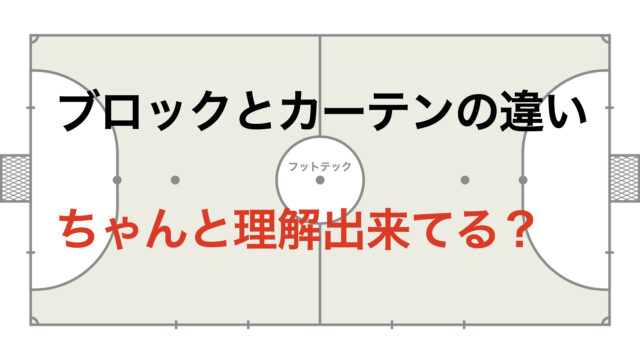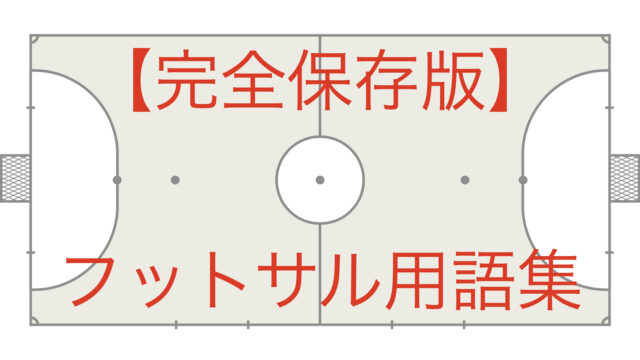If you’ve played soccer, you must have heard countless times that the movement of the third player in attack is crucial.
In futsal as well, attacks involving the third player are, of course, important.
This time, I will outline the concept of attacks involving the third player.
The Importance of Attacks Involving the Third Player
Why is an attack involving three players considered so crucial?
This is because it enables the creation of three types of duo, thereby making a variety of attacks possible.
Mathematically speaking, there are three ways to choose 2 players from 3.
For those who understand the importance of the duo in futsal, the attacks created by the three types of duo are absolutely formidable.
Alternatively, attacks involving the third player are merely an application of the duo concept.
In other words, the duo is the fundamental basis of all group tactics.
This is one of the reasons why every futsal coach places great importance on the duo.
Types of Attacks Involving the Third Player
Attacks involving the third player exist only as 3 on line and triangle (トライアングル).
Mathematically, if you consider the types of figures that can be formed by connecting three distinct points, only two cases exist: one where all three points align in a straight line (3 on line) and one where they form a triangle (トライアングル).
3 on line
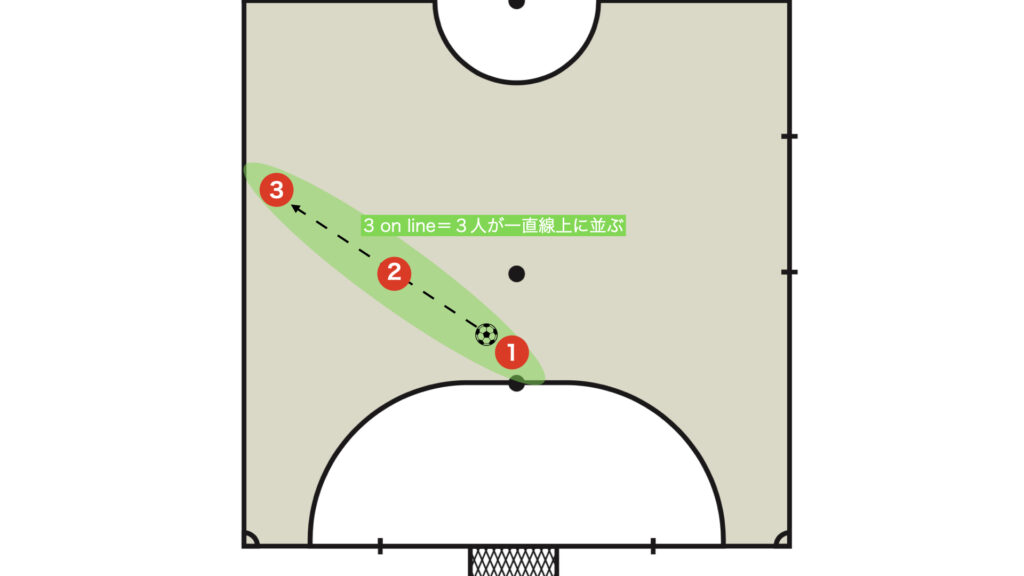
3 on line refers to the state in which three players align in a straight line, and some people even abbreviate it as 1-line (ワンライン).
The tactical purpose of the 3 on line is to break the multiple line structure that the opponent forms to maintain defensive balance.
In particular, the tactic known as “sai”, in which the second player in the middle of the 3 on line steps out, is a mainstream strategy in 3 on line tactics.
The 3 on line can be divided into three types, depending on the angle it forms with the goal line.
- Vertical type: 60°–90°
- Diagonal type: 15°–60°
- Horizontal type: 0°–15°
Let’s introduce each one individually.
Vertical 3 on line
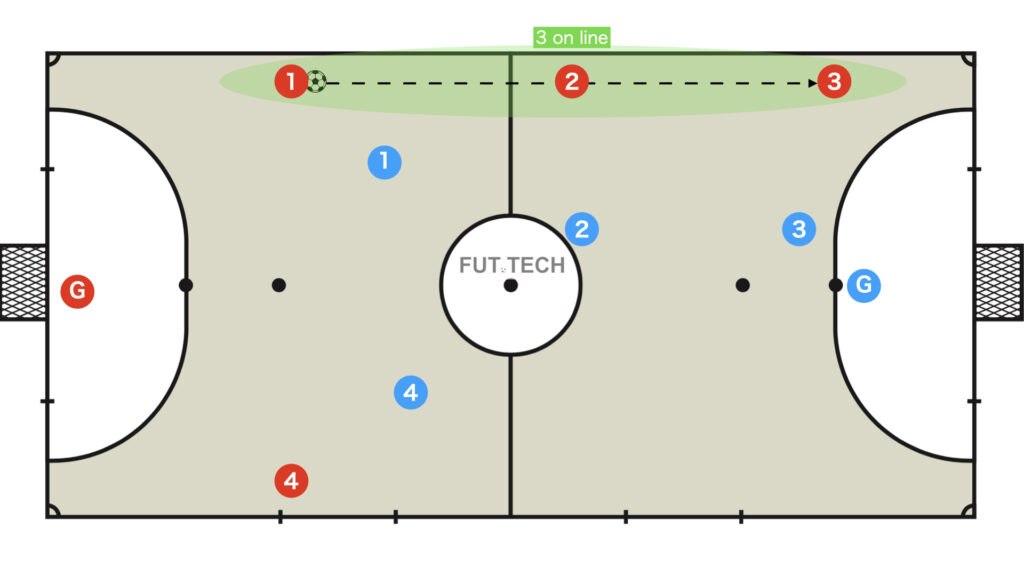
A 3 on line where three players (fixo, ala, pivo) line up vertically (60°–90°).
This formation is commonly seen in a 2-1-1 L-shaped setup and in a 3-1 arrangement featuring a false pivo.
Diagonal 3 on line
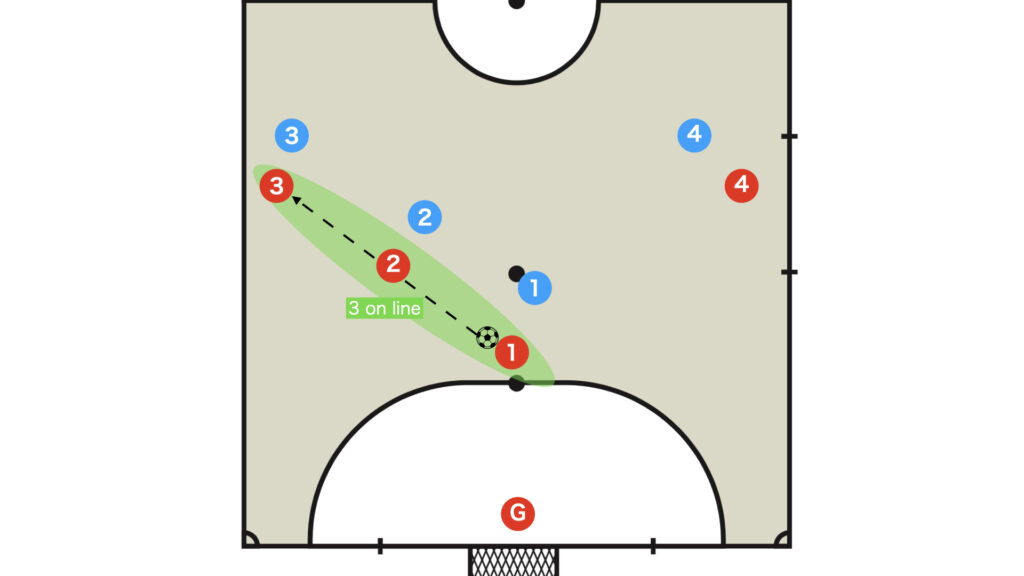
A 3 on line where three players (fixo, fixo, ala) line up diagonally (15°–60°).
This is the 3 on line commonly seen in quatro zero.
Horizontal 3 on line
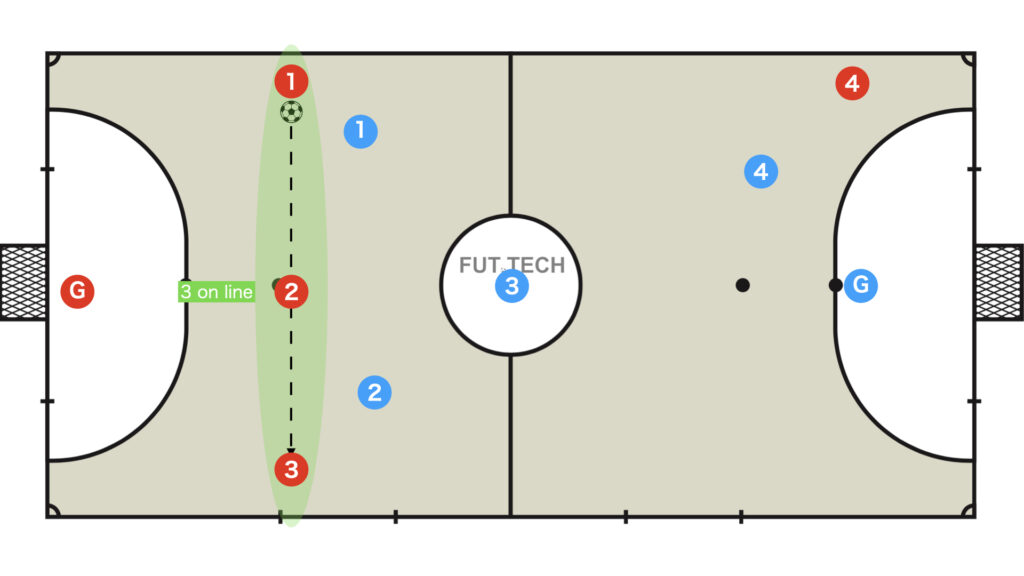
A 3 on line where three players (ala, fixo, ala) line up horizontally (0°–15°).

In competitive futsal, it is common to intentionally create this scenario by having the player in the second row of a 2-1-1 L-shaped formation perform a line cut and drop out of the line.
Among the three types of 3 on line, this is the only one that does not advance, but it is effective as a method to create multiple lines in the opponent’s defense.
Triangle (Triangular Formation)
How many triangles can be formed when no 3 on line is present?
If we consider only the field players, there are 4C3 = 4 triangles, and including the goalkeeper, there are 5C3 = 10 triangles.
While it is not necessary to be aware of every triangle during a game, it is important to understand that this many triangles exist on the field.
3-1 Triangle
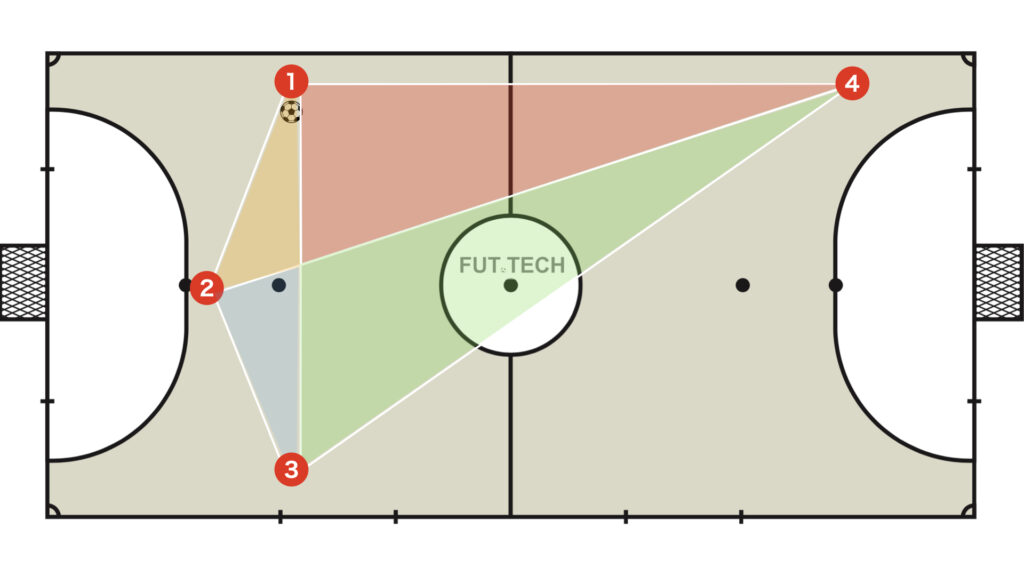
To execute an effective tactic utilizing the pivo, it is important to be mindful of the triangle formed by the duo of the two players behind and the pivo.
Initially, you try to break the defense using duo plays like one-twos or paralela, but when passing is not possible, routing the play through the pivo so that a player breaks free as the third player can create a more potent attack.
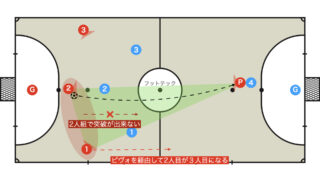
L (エル)

In a 3-1 formation, a tactic known as L (エル) exists, where the pivo, ala, and fixo form an L-shape.
Triangle in Quatro

In quatro, since the pivo is not deployed, the four players are in closer proximity, resulting in the formation of many compact triangles during a match.
The key point here is that each of the four players must not line up vertically; in other words, they should not occupy the same lane.
In principle, defenders position themselves between their mark and the goal to protect it, so if they line up vertically, passing lanes inevitably vanish.
Good Example: Three Passing Lanes Secured with All Players Connected
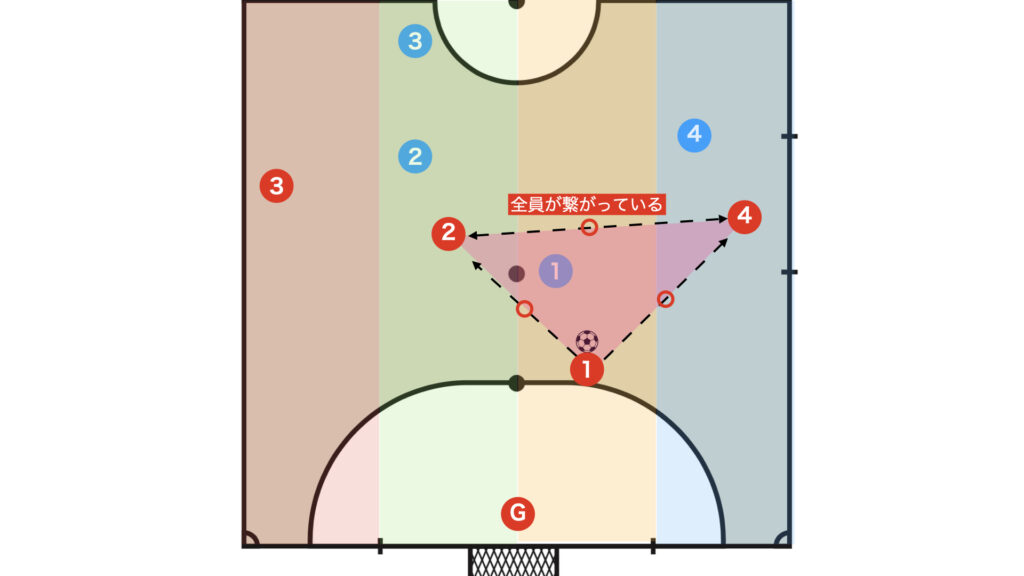
Because the three players are aware of occupying separate lanes and avoiding vertical overlap, three passing lanes remain open.
No matter where the ball is played, two passing lanes are secured, allowing the ball to be circulated with the feel of a 3 vs. 1 cage.
Bad Example: Lacking Three Passing Lanes
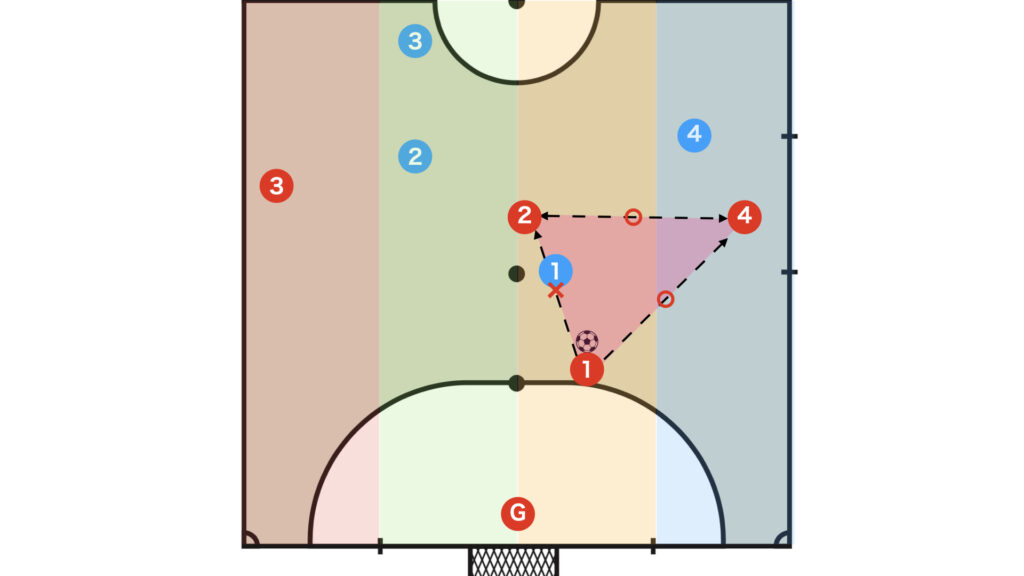
The passing lane disappears because the red number 2 player enters the same lane as red number 1.
Even if the passing lane from red number 1 to red number 2 disappears, red number 1 remains connected to red number 4, and red number 4 to red number 2, so indirectly, red number 1 and red number 2 are still connected.
However, the moment the passing lane between red number 1 and red number 4 disappears, there is completely no outlet. Furthermore, such a phenomenon should never occur as it makes the defense more susceptible to being targeted.
Be Aware of Both the Triangle and 3 on line Simultaneously
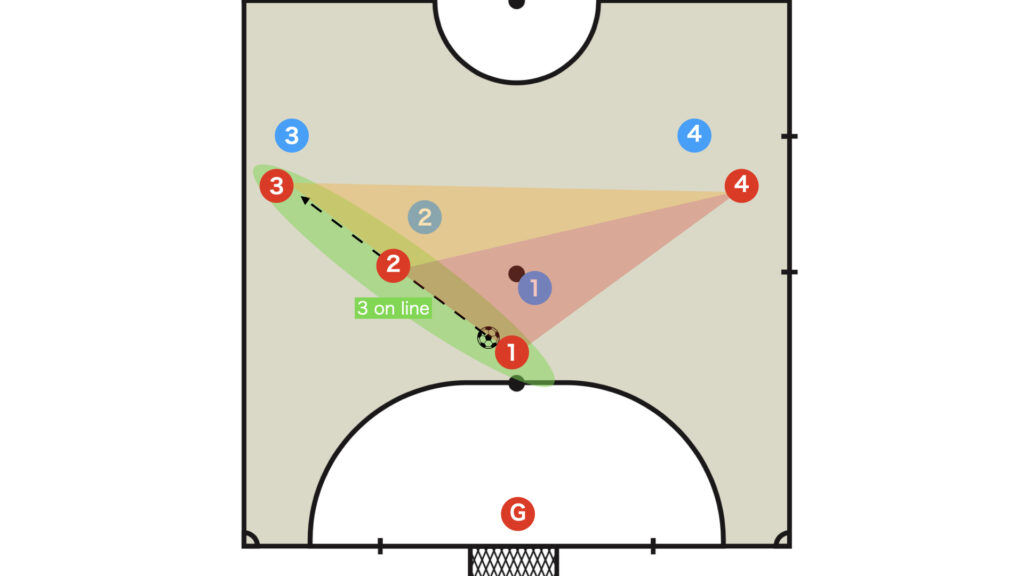
When attempting a three-player tactic, one tends to fixate on either the 3 on line or the triangle, but these are essentially three-player combinations that occur simultaneously.
It is essential to develop the judgment to choose which three-player combination to exploit based on the opponent’s defensive organization.
Supplementary: 4 on line
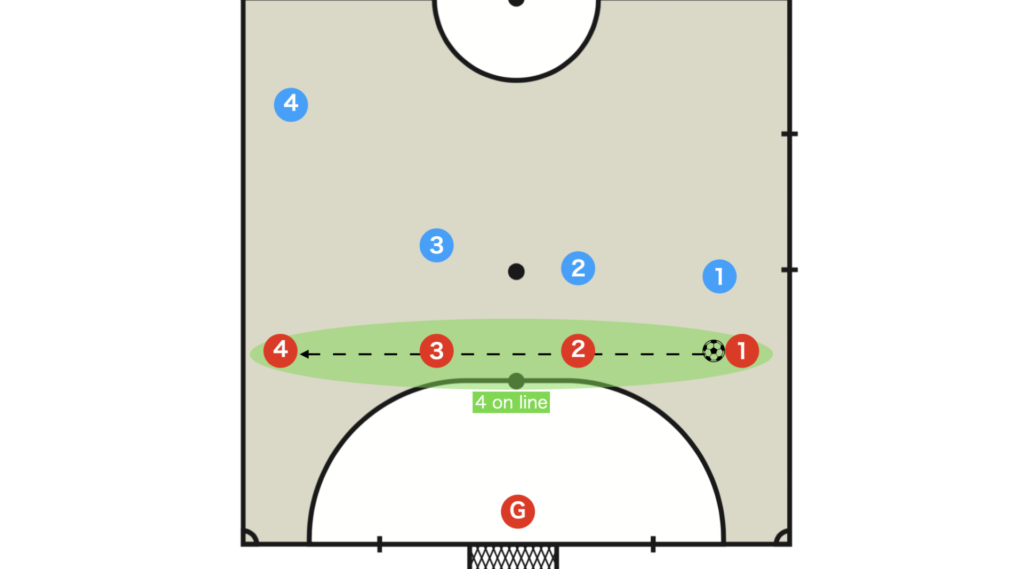
The 4 on line, where four players line up in a row, is a phenomenon that occasionally occurs in quatro zero.
This scenario is a very unique formation in which a triangle cannot be created.
Since 1-line encompasses both 3 on line and 4 on line, using the term 1-line leaves ambiguity as to which formation is being referred to. Although some people occasionally refer to everything as 1-line, it does not accurately describe the situation.
Summary
This article discussed the tactics formed by three players, namely the triangle and the 3 on line. These two concepts are essential elements that must be strongly considered when playing quatro, so if you play quatro, make sure to grasp them.
Being aware of the triangle is very important in any tactic. Try to keep the triangle in mind during your daily practice.
However, since attacks involving the third player rely on the duo, rather than aiming high immediately, it is recommended to focus on practicing the duo first.
Finally, here is a video of the third player’s movement from the University of Tokyo Futsal Club, which was referenced extensively in this article; please watch it with the discussed content in mind.
Thank you very much for reading this article to the end.
If you found this article useful, please consider sharing it using the social media share buttons above.
We regularly share valuable insights on futsal tactics on Twitter, so if you haven’t followed us yet, we’d appreciate your support!
We are committed to raising the level of futsal in Japan by sharing high-quality information through discussions with individuals who have coaching experience in the F.League and overseas.
If you have any questions or notice any mistakes, feel free to leave a comment below.
We update our articles regularly, so if you’d like to keep reading, please bookmark our site or search for “FutTech”!

